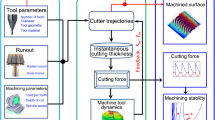Abstract
This paper focuses on solving the bottleneck problem-process simulation in virtual manufacture (VM), a solution of whole process simulation including geometrical aspect and physical aspect is put forward in the domain of laser surface hardening. For the difference of mechanisms among the different laser machining modes, the architecture integrated with the common and the distinction is constructed for the whole process simulation, and it is suitable for all laser machining modes. The virtual processing equipments for the laser machining are built by IGRIP software. The processing model is the map of the processing mechanism and the different models mapping to different machining modes. The whole process modeling of laser surface hardening is described. The extracted modeling parameters comprise geometrics, laser characters, material properties and mechanical properties, the model is built by artificial neural network method, and the finished model is embedded to IGRIP by quadric development. The whole virtual processing is implemented combining the whole model and the visualization simulation, the simulation result including the joints movement of the processing robot, collision-free report, processing effect prediction etc. are output. The analysis for the simulation result and the influence of parameters on processing effect are discussed to guide the real laser machining.
Similar content being viewed by others
References
Nagel R and Dove R (1991) 21st century manufacturing enterprise strategy, an industry-led view. Technical report, Iacocca Institute, Lehigh University, USA
NSF/ARPA, Machine tool agile manufacturing research, http://mtamri.me.uiuc.edu/technicalprogrames/processmodeljuly95.html
Kimura P (1993) Product and process modeling as a Kernel for virtual manufacturing environment. Ann CIRP 42:85–93
Ehmann KF, Kapoor SG, DeVor RE, Lazoglu I (1997) Machining process modeling: a review. J Manuf Sci Eng 119:655–663
Parakkal G, Zhu R, Kapoor SG, DeVor RE (2002) Modeling of turning process cutting forces for grooved tools. Int J Mach Tools Manuf 42:179–191
Mehdi K, Rigal JF (2004) A numerical model for cutting process simulation and prediction of cutting forces in peripheral milling. IEEE International Conference on Industrial Technology (IEEE Cat. No. 04TH8771) 2:734–40
Yang Y, Feng K, Bi L, Jiang YM, Feng B (2004) The 3D numerical simulation of stress field coupled with temperature field in cutting process. 2004 International Conference on Intelligent Mechatronics and Automation (IEEE Cat. No.04EX952), pp 739–741
Sushanta KS, Ozdoganlar OB, Richard ED and Kapoor SG (2003) Effect of groove-type chip breakers on twist drill performance. Int J Mach Tools Manuf 43:617–627
Bason EC, Yung CS (2002) A comprehensive chatter prediction model for face turning operation including tool wear effect. Int J Mach Tools Manuf 42:1035–1044
Balkrishna CR, Yung CS (1999) A comprehensive dynamic cutting force model for chatter prediction in turning. Int J Mach Tools Manuf 39:1631–1654
Ko JH, Yun WS, Cho DW, Ehmann KF (2002) Development of a virtual machining system, part 1: approximation of the size effect for cutting force prediction. Int J Mach Tools Manuf 42:1595–1605
Yun WS, Ko JH, Cho DW, Ehmann KF (2002) Development of a virtual machining system, part 2: prediction and analysis of a machined surface error. Int J Mach Tools Manuf 42:1607–1615
Yun WS, Ko JH, Lee HU, Cho DW, Ehmann KF (2002) Development of a virtual machining system, part 3: cutting process simulation in transient cuts. Int J Mach Tools Manuf 42:1617–1626
Smith S, Tlusty J (1990) Update on high-speed milling dynamics. ASME J Eng Ind 112:142
Jiaa CL, Dornfeld DA (1998) A self-organizing approach to the prediction and detection of tool wear. ISA Trans 37:239–255
Cao T, Sutherland JW (2002) Investigation of thread tapping load characteristics through mechanistics modeling and experimentation. Int J Mach Tools Manuf 42:1527–1538
Zhao H, Ehnamm KF (2003) Mechanistic model for spade drills for wood drills operations, part1: model development. J Manuf Sci Eng 125:226
Kolbe CM (1990) Widefield-application of lasers for the surface treatment of metallic components. Mach Market 96:52–57
Grob MS, Black I, Muller WH (2001) 26th European conference on laser interaction with matter. Proc SPIE 44:236–239
Komanduri R, Hou ZB (2001) Thermal analysis of laser surface transformation hardening. Int J Heat Mass Transfer 44:2845–2862
Woodard PR, Dryden J (1999) Thermal analysis of a laser pulse for discrete spot surface transformation hardening. J Appl Phys 85:2488–2496
Ion JC (2002) Laser transformation hardening. Surf Eng 18:14–31
An YQ, Yu G (1999) Laser surface treatment of carbon steels using diffractive optical converters. Proc. SPIE, AHPLA’99, Japan
Roy A, Manna I (2001) Laser surface engineering to improve wear resistance of austempered ductile iron. Mater Sci Eng A 297(1–2):85–93
Levcovici SM, Levcovici DT, Munteanu V (2000) Laser surface hardening of austenitic stainless steel. J Mater Eng Perform 9(5):536–540
Udo GJ (1992) Neural network applications in manufacturing processed. Compu Ind Eng 23:97–100
Zhang H, Huang SH (1995) Applications of neural networks in manufacturing: a state-of-the-art survey. Int J Prod Res 33:705–728
Guessasma S, Montavon G, Coddet C (2004) Modeling of the APS plasma spray process using artificial neural networks: basis, requirements and an example. Comput Mater Sci 29:315–333
Smith LN, German RM, Smith ML (2002) A neural network approach for solution of the inverse problem for selection of powder metallurgy materials. J Mater Process Technol 120:419–425
Jain C, Vemuri VR (Eds.), Industrial Applications of Neural Networks, Boca Raton: CRC Press LLC, 1999, ISBN 0-8493-9802-9
Author information
Authors and Affiliations
Corresponding author
Additional information
This work is financially supported by the Key Projects for Device Development (No.[1997]167) and for Knowledge Innovation (No.KGCX1-11) of the Chinese Academy of Sciences, which are gratefully acknowledged.
Rights and permissions
About this article
Cite this article
Zhang, T., Xiao, T. & Yang, B. The process simulation of virtual laser surface hardening. Int J Adv Manuf Technol 37, 690–697 (2008). https://doi.org/10.1007/s00170-007-1008-x
Received:
Accepted:
Published:
Issue Date:
DOI: https://doi.org/10.1007/s00170-007-1008-x




